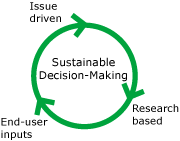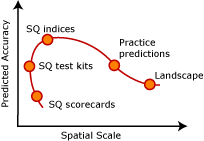Soil Quality Tools: Methodology and Toolkits for Managed Land Evaluation
Researchers have developed practical tools to assess how management practices affect soil quality and ecosystem function.
The best choice of the available tools will depend on:
- the specific soil-quality assessment and land-use objectives
- the time, money, and skills available to collect data
Because dynamic soil quality indicators vary widely with soil, universal calibration of soil quality indicators is not generally possible. One cannot take a sample, analyze it and interpret it independently; rather one must rely on comparative data for interpretation that includes:
- long-term measurement of indicators from the same site or soil type
- laboratory characterization data
- published research results from NRCS databases
- even hypothetical data for "what-if" scenarios
 Practical tools for soil quality assessment should:
Practical tools for soil quality assessment should:
- be accurate, simple to use and meaningful
- be site-specific
- have standards and guidelines for interpretation
In general, the development of soil quality assessment tools has followed a paradigm for sustainability. They are:
- issue driven - soil degradation fuels development
- research based - sound science backs up indicator and index development
- end-user in mind - input has been sought to increase utility.
 Because the constraints for a farmer are different from a researcher, and because opinion is mixed on which indicators or suites of indicators are the most useful, researchers have proposed a wide range of soil quality assessment methodologies. Several different types of tools have been or are being developed. Each type of tool has a different level of accuracy, appropriate spatial scale, and intended use.
Because the constraints for a farmer are different from a researcher, and because opinion is mixed on which indicators or suites of indicators are the most useful, researchers have proposed a wide range of soil quality assessment methodologies. Several different types of tools have been or are being developed. Each type of tool has a different level of accuracy, appropriate spatial scale, and intended use.
Types of Soil Quality Assessment Tools
Qualitative Scorecards - provide lists of observable soil indicators (often developed by farmers) that are qualitatively evaluated by land managers repeatedly over time to monitor changes in quality. Visit the NRCS Soil Quality web site for more information on qualitative scorecards and state examples.
Field Test Kits - refers to any suite of in-field soil tests conducted by land managers to provide semi-quantitative data. Kits have been developed in the U.S., New Zealand and Australia. See Soil Quality Test Kit for more information and support tools.
Lab-based assessments - assessments based on indicators requiring more specialized equipment or more precise measurement than possible with field test kits, such as microbial biomass carbon, soil test phosphorus or potentially mineralizable nitrogen. These include the Soil Management Assessment Framework available at this web site and the Cornell Soil Health Assessment.
Practice Predictors - use research outcomes to predict the effects of management practices on soil quality. The NRCS Soil and Water Eligibility Tool (SWET) and Conservation Measurement Tool (CMT), are examples of this type of assessment tool.
Landscape-level assessments - use satellite and remote sensing technology to assess resource quality at large spatial scales. Using remote sensing to predict soil carbon storage is one possible use for this type of assessment.
Multi-factor sustainability tools, which combine environmental, economic and social indicators, are a logical outgrowth from soil quality assessment of agroecosystems due to the important relationship between soil quality and sustainability. These include a proposed Sustainability Index.
